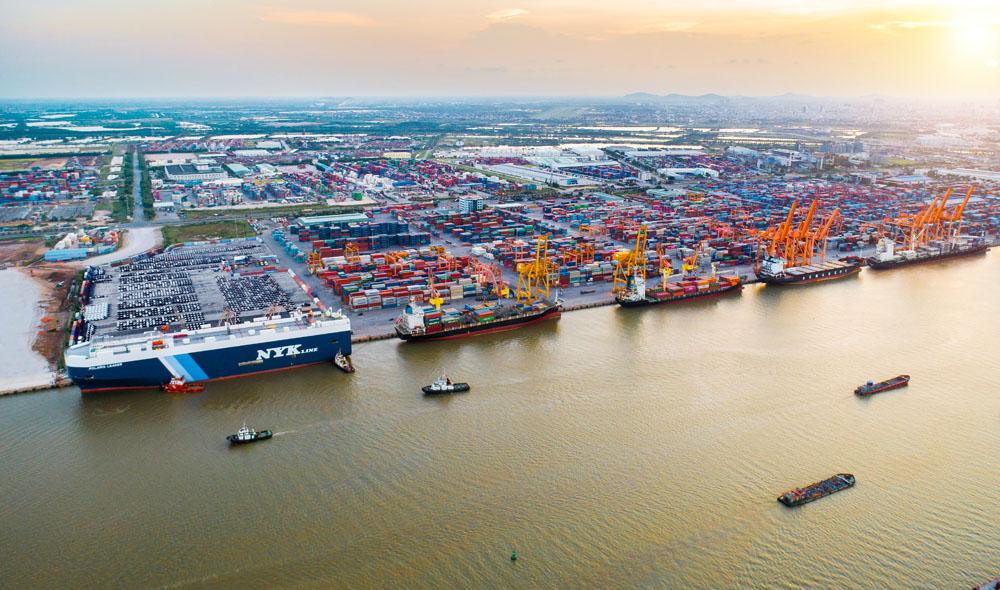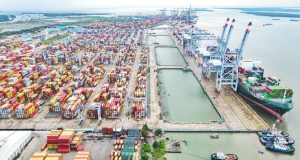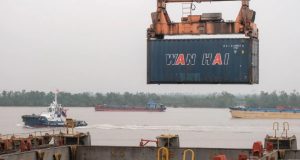Driven by a decade-long record high in trade, container throughput via joint venture seaports between shipping giant Vietnam Maritime Corporation and its foreign partners continued growth momentum in the first four months of 2021.
According to statistics from Vietnam Maritime Corporation (VIMC), total container throughput shipped via Cai Mep International Terminal (CMIT) reached over 610,000 twenty-foot equivalent units (TEUs) between January and April, up 16.47 per cent on-year, while its revenue increased 1.05 per cent on-year to $15.7 million.
CMIT deputy director Nguyen Xuan Ky told VIR, “We performed well in 2020, and the growth momentum continues in the four months of this year despite the pandemic. The growth in volume of goods via CMIT is attributed to strong growth in exports to the United States. Currently, goods via the seaport are mostly sourced from southern economic hubs. Our seaport capacity already surpasses the designed capacity.”
The seaport, a joint venture (JV) between VIMC and Denmark’s APM Terminals in the southern province of Ba Ria-Vung Tau, is considered the most profitable JV seaport between VIMC and its partner.
During the period, the performance of VIMC’s three other JV seaports also improved. In particular, SSIT – from VIMC and SSA Marine in the Cai Mep-Thi Vai area – reported on-year improvement of 238.65 per cent to 284,766 TEUs.
SSIT also reported a surge of 79.56 per cent in revenue during the period, hitting $11.68 million. Similarly, SP-PSA, a JV with Singapore-based PSA, continued to see no container throughput during the span, while its revenue ascended by 49.13 per cent on-year to $3.34 million.
Q1 of 2021 witnessed an on-year rise of 8.42 per cent in revenue for the Cai Lan International Container Terminal (CICT), a JV between US-based Carrix and VIMC. However, its container throughput fell over 98 per cent on-year. Located in the northeastern province of Quang Ninh, CICT was estimated to handle a total of 1.4 million tonnes of goods during the period, down 15 per cent on-year.
These results are encouraging amid the current developments of COVID-19. Remarkably, CMIT, SSIT, and SP-PSA all witnessed strong increases in total volume of goods shipped via them (see box).
In the same period last year, SP-PSA also reported no container throughput, while its volume of goods in bulk fell 15 per cent on-year to around 710,00 tonnes. As a result, this JV recorded a revenue of $1.6 million, equal to a mere 88 per cent of the same period of a year earlier.
Between January and March of that year, CMIT’s container throughput rose just 8 per cent, while revenue went up 2 per cent. Also, SSIT saw its volume of goods in bulk climb by just 1 per cent on-year.
Nguyen Canh Tinh, CEO of VIMC, told VIR, “Despite the pandemic, manufacturing and business activities in Vietnam still remain stable, thus enabling the smooth flow of goods. As a result, our seaport segment saw positive results.”
The better performance is attributed to a 10-year record high in the country’s trade growth during the first four months of 2021.
According to the General Statistics Office, the country’s trade turnover is estimated to hit $103.9 billion, up 28.3 per cent on-year, while its total import value reached $102.61 billion, up 30.8 per cent. The United States, China, and the EU remain Vietnam’s biggest export markets.
As maritime transport still makes up 90 per cent of the country’s total imports and exports, the great growth in trade is a driving force to spur the seaport segment.
With the improvements, VIMC’s total volume of goods shipped via its ports reached over 44.11 million tonnes in the first four months, up 27.14 per cent compared to the same period last year, while the giant’s total container throughput, and total revenue of the seaport segment up 24.71 per cent and 20.53 per cent on-year, respectively.
The seaport segment has been the best performer among VIMC’s core businesses. After enduring years of setbacks due to economic downturn and other difficulties in the shipping market, the JV seaports have experienced constant increases in the volume of cargo since 2018. The growth momentum continues thanks to the country’s general success in pandemic control. In 2020, they enjoyed about 5-10 per cent on-year rise.
The JV seaports, especially CMIT, have been upgraded to accommodate big container vessels. Ky of CMIT elaborated, “We are making big investment in improving equipment and infrastructure to increase the service quality. We expect that our seaport is likely to surpass the target set earlier for 2021.”
This result is expected to enable the group to pin high hopes on the possibilities of achieving the targets of handling about 114 million tonnes of goods, and over 5.12 million TEUs in container throughput this year.










